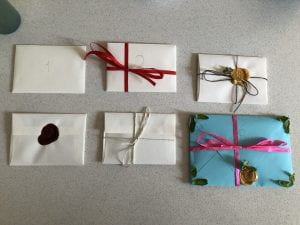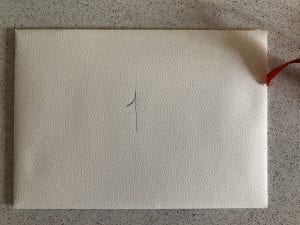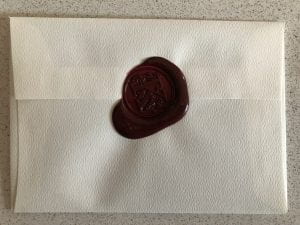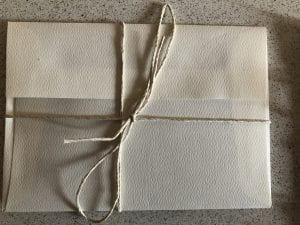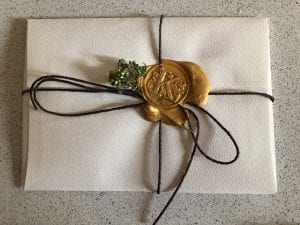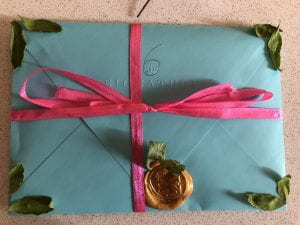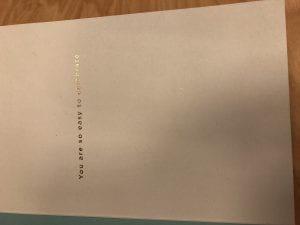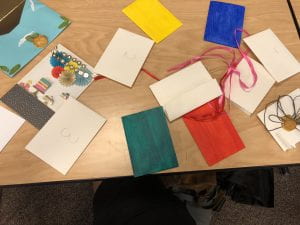Sky Piece:
Find a Tall Roof
Look Over The Edge
Count the Cars
Fall Upwards
Count the Stars
Tend to the Light at the End of the Tunnel

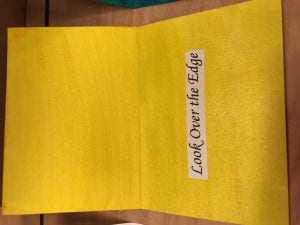

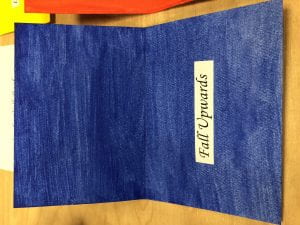
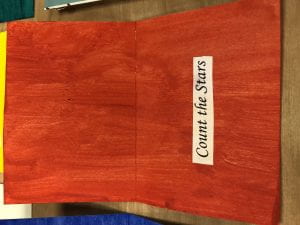
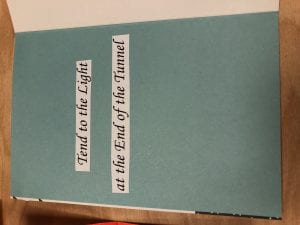
From its inception, Sky Piece was intended to be a contemplative homage to some of Yoko Ono’s most open-ended and perhaps more existentially geared scores. In particular, I was inspired by much of her more metaphorical work in Grapefruit that didn’t seem performable or would yield no material results but could bestow a particular insight and motivate reflection or introspection. I originally considered having readers actually perform the piece, finding a tall roof at which they would find the next line, and so on. However, there seemed to many variables and safety concerns to this, so I compensated for that sense of adventure/discovery by placing all of the lines in a box once they had been packaged. The main inspiration for this was the kind of childlike wonder that Flux kits seemed to evoke. There is no underestimating the mystery and excitement that comes with the prospect of a sealed box, even one as dilapidated and worn out as the one I decided to use.
The state of the box, of course, was chosen to contrast with its contents and to prove the prior point about how eager we are to resolve the uncertain even when hidden by the poorest, least attractive means. Inside the box performers would find six envelopes, all numbered, increasing in aesthetic complexity as each line is unpacked, opened, read, and then unpacked in the performer’s mind before moving on to the next line. The decision to place each line in an envelope was motivated by a need for progression and pacing. Each package introduces a new element or combination of materials usually found on decorated envelopes, increasing in quality and complexity until the very last one. Each envelope is trying to convey something to the performer, just as each line of the score they contain. Similarly, the progression of the envelopes mirrors the progression of the score’s themes and perspectives, reaching death via the commodification by the last card which is a cheesy Hallmark birthday card that contains the line about “the light at the end of the tunnel”.
The score itself is meant to be a a sort of call to perspective. Many of us desire progression/ascension in our daily lives (take climbing the corporate ladder for example) but often fail to place ourselves above the hustle and bustle of daily life. I had originally wanted performers to seek out that height literally by asking them to find a tall roof, but figured everyone has at least once and should be able to recall the perspective it gave them. Regardless, finding a tall roof is simply to look upon/consider the rat race from the top down. The card this line is on is not colored, as the others are, to represent the beginning of a new journey/endeavor.
“Look over the edge” asks of the performer to either do something they are not inclined to (perhaps out of fear) or to do what logically comes next (depending on how you feel about roofs). Regardless of the positioning granted by the previous line, one must peer into the void if they are to discern its contents. This line is an explicit call to action, the application of which, made implicit by the first line, could be easily ignored. The card this line is on is therefore painted yellow, a color often associated with fear and trepidation and something that I wanted to use to guide the contemplative performer’s sensory experience into the state of mind of the literal performer. This is a recurring theme among the cards.
“Count the cars” and “Count the stars” are two very similar lines with very similar interpretations, but they mirror each other (both in rhyme and symbolism) because the ideal performative (and contemplative) outcome is to gaze down at a sea of cars and then look up to find a similarly thorough spattering of gaseous balls of fire across the sky. This is, of course, impossible because the emissions made by automobiles make it impossible to see stars, and so wherever there are plenty stars there are usually much fewer cars. The juxtaposition is a handy insight into the influence of our technological progression on our ability to keep the stars in sight and all that entails (health concerns over greenhouse gasses as well as the fact that no city kid can ever look up at the stars and imagine a universe ripe for adventure). This theme itself stands in contrast to the grandiosity implied by the contemplative outcome of being told to count the cars and then count the stars. Ideally, the performer in this scenario would draw a connection between the number of cars and the number of visible stars in the sky. In doing so, I want the performer to consider our place in the universe, whether we are truly alone, and whether that really even matters. It is reasonable to consider that, even though we may be totally alone in the universe, our existence has still managed to proliferate thoroughly and will likely continue to do so such that we echo the presence of our very own cosmic background; such that we occupy so many cars on our worlds as there are visible stars in the sky (the dust of which it is often said humans are composed of). The “Count the cars” card is painted green for nature and Earth in irony of the message it contains about loud, polluting machines. They may be cold, sterile machines, but they are of the earth and unto the earth they will return. “Count the stars” is painted a fiery red/orange for the actual color of stars as they burn in the vacuum of space and for the color that penetrates our eyelids when we close our eyes in the sun.
“Fall upwards” mediates both “count the cars” and “count the stars”. Upon visiting a roof, one’s first thoughts are often of the height they are at, of falling and what that would be like; the wind rushing past you at unimaginable speeds as the narrow becomes wide and the pavement rises up to meet you. Will I hit a car? Would I fall on somebody? I wanted to subvert this commonality and observe its effects on the performer. How would they envision it? Would it be a simple floating or would a similar rush inevitably come to mind? There is no floor at the top so how would it feel to cross the layers of the atmosphere? Would you ever reach a star falling upwards as easily as you would reach a car? In a lot of ways, “look over the edge” and “fall upwards” are the same line, but the former carries an implication explicit in the latter, while the latter is a more direct catalyst for the imagination. The card this line is on is blue for the color of the sky that will inevitably surround you on your ascent.
The final line, “tend to the light at the end of the tunnel” is a reference to the fact that all things end in death regardless of the perspective or meaning that they have conjured, been confronted with, or otherwise maintained. Whether you fall off the edge as is implied in “look over the edge” or you “fall upwards” into the vacuum of space, the only certainty is that death awaits. Furthermore, regardless of what you discover in life, you can discover nothing beyond the true final frontier that is death. There is no plane that supersedes the one we occupy to our knowledge, and there is no knowledge that seems to apply to the death-state. We can only guess at the game we are playing as we hurtle towards an uncertain end, the nature of which we may never truly grasp, and so we wait by the door, letting the anxiety and uncertainty that it incites occupy our state of mind. We “tend to the light at the end of the tunnel” in a way no other creature does. This card is white, because rather than paint it black and imply nothingness, I wanted the endless possibility implied by the first card to bookend the performer’s experience and provide an optimistic outlook on the nature of death and its implications for the human soul.
The card itself is a cheesy hallmark birthday card with the inscription “You are so easy to celebrate” written on the inside. I found this interesting because, while the final card is supposed to represent the death of art through commodification, the inscription it came with was similarly a capitalist nail in the coffin for the very meaning I wanted the score to attribute to the experiences of the individual. Yes, you are supposed to be easy to celebrate, but its one thing when I suggest that its because you are a miraculous expression of the universe’s will in an attempt to experience itself and another thing entirely when your aunt carol buys you this card and calls it a year.
This stands in stark contrast to the point made by the other cards. Just as I wanted the performer to have an aesthetic experience in reading the score itself, I wanted the aesthetics of the presentation to promote an italicization of experience; for the performer to feel every untying of a ribbon or string, the snap of a wax seal as it comes off the envelope, and the smell of each distinct perfume in the latter three envelopes. Each card built on or explored a possibility presented by the last, mirroring the journey of discovery implied by the score, until the performer’s arrival at an overdone, wonky mess of a last card that seemed more ornate but less deliberate; a product rather than a labor of love.
